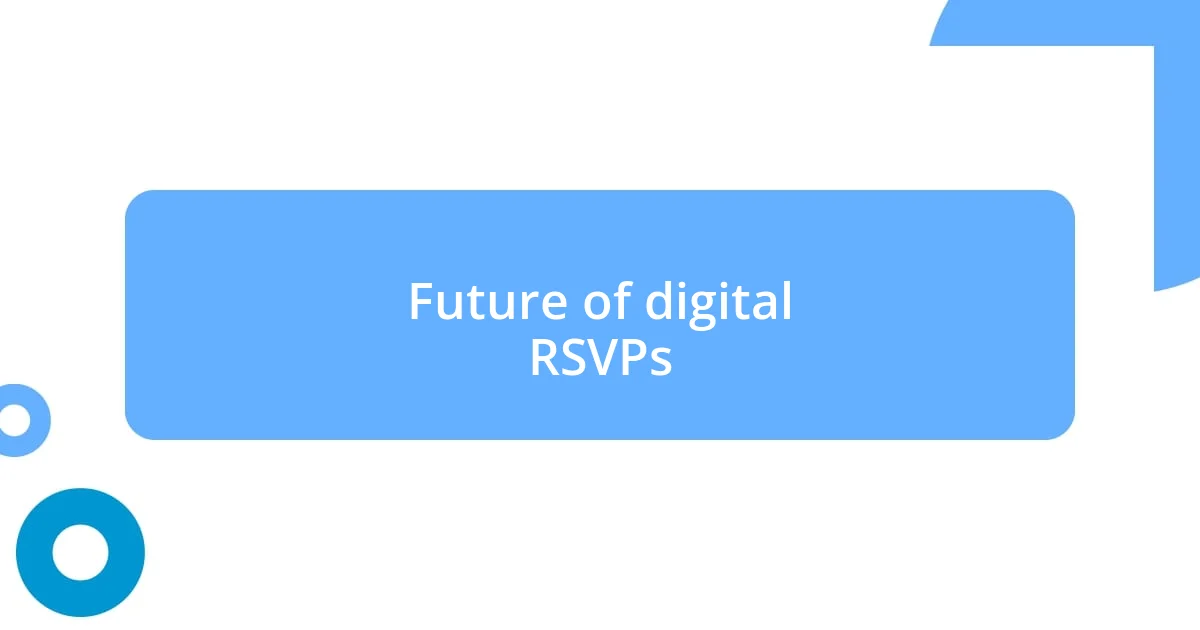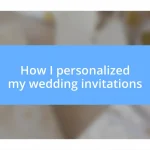Key takeaways:
- Digital RSVPs improve efficiency but can lead to a lack of personal touch and confusion among guests unfamiliar with technology.
- Common challenges include technical difficulties, unclear instructions, and the need for timely reminders to ensure a smooth RSVP process.
- The future of digital RSVPs may involve greater integration with daily life, AI personalization, and enhanced accessibility for all users.

Understanding digital RSVPs
Digital RSVPs have transformed the way we respond to invitations, making it easier to connect without the hassle of physical cards. I remember planning a friend’s wedding recently, and the efficiency of digital RSVPs stood out. No more lost envelopes or misplaced stamps; the instant feedback made it much easier to manage guest lists!
Yet, I can’t help but wonder—do we sometimes lose the personal touch with these technology-driven solutions? When I received a digital RSVP for one of my own events, I felt a bit detached. An email lacks the warmth of a handwritten note, doesn’t it? I appreciate the convenience but crave that personal connection.
Moreover, the variety of platforms can be overwhelming. There are countless apps and websites, each with its features and quirks. I once chose a platform that seemed perfect, but it led to confusion for my guests, who struggled with the tech. It made me realize how important it is to consider my guests’ comfort with digital tools when planning events.

Common issues with digital RSVPs
Digital RSVPs can certainly make life easier, but they also come with their share of challenges. I’ve encountered guests who simply don’t understand how to complete an online RSVP form. For instance, during my sister’s birthday party, I had one guest who was so tech-averse that they ended up texting me their response instead. That’s when I realized that despite the benefits, we can’t assume everyone is comfortable with digital solutions.
Another common issue I’ve seen is the lack of clarity in the RSVP process. When I was organizing a family reunion, I used an app that didn’t clearly communicate the event’s details to guests. Some people assumed it was a potluck based on the form, leading to confusion and duplicate dishes! It was a learning experience for me, highlighting the importance of clear instructions and adequate guest support.
Not to mention, the risk of technical glitches is always looming. I remember when a online platform crashed just days before my friend’s wedding. Thankfully, we had a backup plan, but not everyone was so fortunate. These experiences have taught me to always have a plan B for digital RSVPs, for the peace of mind it brings.
| Common Issues | Impact on Guests |
|---|---|
| Technical Difficulties | Guests may struggle to navigate the RSVP process. |
| Lack of Personal Touch | May lead to guests feeling disconnected from the host. |
| Assumptions about Tech Savviness | Some guests may not feel comfortable using digital tools. |
| Clarity of Information | Ambiguous instructions can result in misunderstandings. |
| Technical Glitches | Can create last-minute chaos for event organizers. |

Tools for managing RSVPs
When it comes to managing RSVPs, a variety of tools can streamline the process. I’ve had hands-on experience with platforms like Eventbrite and Paperless Post, which not only simplify RSVP management but also enhance the overall guest experience. I was amazed by how intuitive these tools can be; during my daughter’s first birthday party, the RSVP system allowed me to track responses in real-time, which took a load off my shoulders as I focused on the fun details.
Here’s a quick rundown of popular tools and their features:
- Eventbrite: Excellent for larger events, with ticketing options and seamless integration for reminders.
- Paperless Post: Offers beautiful, customizable invitations and RSVP tracking that exudes a personal touch.
- Google Forms: An easy, no-cost option that anyone can use, but may lack the design flair of other platforms.
- Evite: Known for its friendly user interface; it’s perfect for casual gatherings, but sometimes feels less formal.
- Facebook Events: Great for inviting friends, but I often find that not everyone checks their notifications regularly, leading to missed responses.
It’s essential to find a balance between features and ease of use. I once tried a fancy app laden with options but quickly found it overwhelming—not just for me but for my guests, too. I couldn’t help but feel frustrated when I was met with a flood of questions about how to RSVP, and it made me realize the importance of choosing a platform that aligns well with your audience’s comfort level.

Best practices for digital RSVPs
When sending out digital RSVPs, clarity is absolutely key. I recall a recent experience where I created an online link for an engagement party, but I forgot to specify the RSVP deadline clearly. As a result, responses trickled in late, leaving me scrambling to finalize arrangements. It made me wonder: how can a simple deadline notice make such a difference in planning?
Interestingly, I’ve found that personal touches can go a long way in digital RSVPs. For my cousin’s wedding, we opted for a more interactive RSVP page that included fun polls about song selections. Not only did this engage our guests, but it also made the whole process feel less robotic. Have you ever experienced the warmth that comes from a simple question in an RSVP? It transforms the experience from a transaction into a shared moment.
Another best practice I’ve adopted is testing the RSVP process before sending it out. I remember the panic on my face when I realized a crucial checkbox was hidden during my best friend’s baby shower invitation. I promptly enlisted a few friends to test it out, which brought to light several tweaks I hadn’t considered. This small step not only saves time but also ensures that your guests move seamlessly through the RSVP process. It’s almost like giving them a streamlined highway instead of a bumpy road!

Personal experiences with digital RSVPs
There was a time during a family reunion when I decided to use an online RSVP tool for the first time. Despite my enthusiasm, it quickly turned into a headache when I realized not everyone in the family was tech-savvy. I watched as relatives struggled to navigate the site, sending me texts for help. It really made me question, how can something meant to simplify planning create such friction instead?
On another occasion, I encountered an unfortunate RSVP fail when I forgot to follow up with guests who hadn’t responded. The day before the event, I was left with a blurry guest list and a lot of unanswered questions. Can you imagine the stress of not knowing how many people to expect? It was a real eye-opener for me; I learned that reminders are just as crucial as the initial invites in ensuring people actually respond!
Then there was my attempt to set up a digital RSVP for my son’s birthday party using a colorful online platform. I thought I had chosen the perfect design—it was vibrant and engaging—but I quickly discovered that the process was somewhat convoluted. As I received feedback from parents who found the steps confusing, I couldn’t help but sigh. It prompted me to ponder, how important is simplicity in an RSVP? That experience taught me that while aesthetics are enticing, clarity and user-friendliness hold the true value.

Solutions to RSVP challenges
One effective solution I discovered for the digital RSVP challenges is the use of clear, concise instructions. At my sister’s bridal shower, I included a step-by-step guide within the invitation. It felt empowering to break down the process; guests found it easier to navigate and respond. Hasn’t a little guidance made a world of difference during tech hiccups for all of us?
Engaging reminders have also proven to be game-changers in my experience. I remember sending a friendly nudge two weeks before my friend’s birthday bash. The responses flooded in afterward, and it got me thinking: do you ever realize how a gentle nudge can rekindle excitement and prompt action? It transformed a static invite into an ongoing conversation, making it easier for everyone to commit.
Lastly, I’ve started using more user-friendly platforms that cater to diverse tech skills. At my last event, I chose a service that not only looked appealing but was also incredibly intuitive. There was something special about watching my grandmother easily submit her RSVP without needing my assistance. It really raised a question for me: can design enhance user experience to the point where it becomes universally accessible? Finding that balance of beauty and simplicity truly cut down on my stress as a host.

Future of digital RSVPs
As I look ahead, I see a future for digital RSVPs that’s increasingly integrated with our daily lifestyles. Imagine getting a gentle reminder through your favorite messaging app, effortlessly linking you to the RSVP page. Wouldn’t that streamline the process and keep our busy lives organized? This kind of seamless integration could make responding even more instinctive, bridging the gap between technology and user experience.
I also envision platforms harnessing AI to predict guest preferences and demographics. Just think about it: an RSVP tool that personalizes invitations based on past events and interactions could reduce the anxiety of planning. I remember how overwhelmed I felt planning my sister’s wedding; what if there had been a system that considered guests’ preferences, making it easier to compile a tailored invite list? That predictive capability could truly transform how we view digital RSVPs—turning them from a chore into an enjoyable part of the planning process.
Moreover, I believe that accessibility will become a cornerstone of future digital RSVPs. Enhancements catering to diverse abilities could ensure that everyone, regardless of their tech skills, can navigate these tools with confidence. I recall the awkward moment when my uncle, who isn’t particularly tech-savvy, struggled to RSVP online for a family event. Wouldn’t it be wonderful if the future brought us platforms that automatically provided assistance tailored to individual needs? That would not only ease our planning burdens but also foster inclusivity, ensuring no one feels left out of the celebration.














